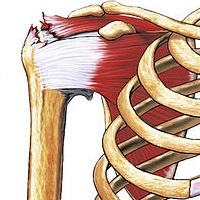
Photo from wikipedia
The purpose was to evaluate the clinical and radiological results of knotless repair with flat-braided suture in full small-sized supraspinatus tendon tears ( Click to show full abstract
The purpose was to evaluate the clinical and radiological results of knotless repair with flat-braided suture in full small-sized supraspinatus tendon tears (< 1 cm). A consecutive series of 54 patients with isolated small supraspinatus tendon tear (< 1 cm and Goutallier index < 2) was evaluated in the study. Patients underwent a knotless arthroscopic repair using flat-braided suture (2 mm wide). Minimal follow-up required was 5 years. Changes in Murley–Constant score, ASES score, strength, and pain relief were assessed. The Sugaya score was used to confirm the tendon repair on MRI. Data were analyzed in two subgroups: technique with additional U point for dog ear deformity (group 1) and technique without additional U point (group 2). The immobilization period was 3 weeks long. Passive mobilization was immediate. Fifty-four patients were included. Mean age was 57 ± 4 years. The average follow-up was 68 ± 10 months. Average preoperative score of Constant was 51.2 ± 8.5 and 83.1 ± 14.6 at the end of the follow-up (p < 0.001). Mean VAS went from 5.8 ± 1.8 to 1.9 ± 2.1 (p < 0.001). Average forward elevation of the shoulder went from 86.3° ± 9 preoperatively to 169.6° ± 15.9 at the end of the follow-up (p < 0.001). The strength score was significantly higher post-operatively (18.4 vs. 8.3, p < 0.001.). The ASES score was significantly improved 49.1 ± 13.1 vs. 88.6 ± 15.8, p < 0.001). The MRI assessment revealed 94% of Sugaya 1–2. No significant difference was observed between group 1 and 2 regarding all clinical outcomes. Two complex regional pain syndromes were described with a favorable evolution. Three patients presented a retear requiring an iterative arthroscopic repair. The use of a knotless arthroscopic construct with flat-braided suture for small supraspinatus repair achieved excellent structural and clinical results. This technique is fully adequate for the arthroscopic treatment of such tears, enabling early mobilization. Level III.
Journal Title: Knee Surgery, Sports Traumatology, Arthroscopy
Year Published: 2020
Link to full text (if available)
Share on Social Media: Sign Up to like & get
recommendations!